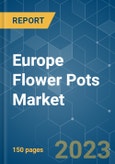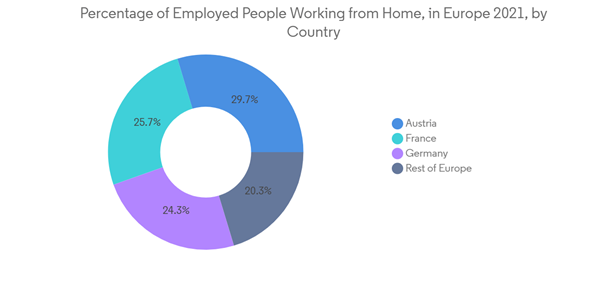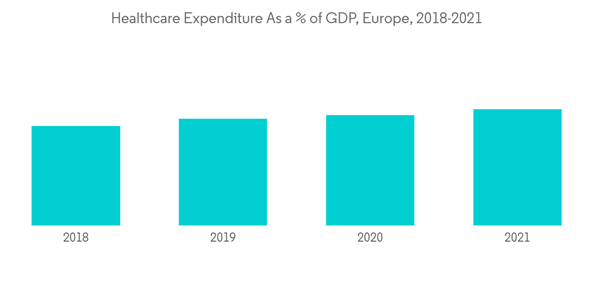Nursery planters and pots are items or containers used for growing or displaying plants like flowers, vegetables, and herbs. The market has nursery planters and pots in a variety of sizes, styles, and designs. Owing to people's love of gardens, there has been an increase in the demand for nursery planters and pots. Because plastic pots have a negative influence on the environment, producers are making recyclable plastic pots. To draw in new customers to the market, producers in the area are creating inventive nursery planters and pots. To satisfy end-user demands, they choose inexpensive raw materials and decorations. Additionally, this presents a large market expansion opportunity for the major firms present in the European nations.
In the instance of COVID-19, Europe, particularly France, saw an extraordinary increase in cases, which caused the manufacturing of nursery planters and pots to cease. Early in the following year, the decline in other industries that produce consumer products had a detrimental effect on the market for nursery planters and pots. Additionally, the drop in container manufacturing activities resulted in the cancellation of projects to manufacture nursery planters and pots, which decreased the need for nursery planters and pots. Similar trends were seen in other European nations like Germany, Italy, Spain, France, and the United Kingdom. However, the economies of the countries projected recovered from this decline in demand when they pick up speed in the following year.
Moreover, Germany, the United Kingdom, and France are the top importers of garden pots in Europe. An estimated 40 million adults in Britain, roughly 77% of the population, have a garden. Around 40 million French citizens, or 60% of the population, are said to have gardens. In addition to the numerous consumers who use a balcony or patio space to have a few potted plants, 36 million Germans over the age of 14 own a garden. In comparison to Germany, which boasts up to 45 million hobby gardeners, the United Kingdom is home to an estimated 27 million gardeners. Additionally, 17 million consumers in France actively garden. They spend a lot of time gardening: 29% of Britons, 34% of Germans, and 28% of French people labor in the garden at least once each week. Only 20%-29% of respondents say they never garden at all.
Growing in popularity are indoor potted plants. Modern homes’ preference of interior décor has changed, which boosted the need for pots in the residential market. Vases, flower pots, and other containers all enhance a room's aesthetics and create a positive atmosphere. To promote the flow of energy in the home, the ancient science of design, architecture, and layout, which encompasses Feng Shui, Vaastu Shastra, and the Malay system, greatly emphasizes planting plants in a particular direction. The community of garden enthusiasts concentrates on creating gardens in their verandahs and kitchen using little and large gardening pots.
Europe Flower Pots Market Trends
Change in Consumer Behavior and Increase in Time Spent Indoors is Driving the Market
Consumers, especially senior citizens, are provided shelter at home. With a cozy, quite opulent environment, the consumer creates a haven that is a world in itself. Home sweet home is also about families or groups of friends having fun together, cooking and dining together, or simply unwinding. The COVID-19 pandemic strengthened these two aspects of indoor dwelling. Using plants to cozy up a space is crucial, and making the garden and balcony an extension of the house has been a long-standing tradition. It is now equally decorated and done so in a way that carries the internal aesthetic outside.Large portions of the workforce migrated to working from home during the pandemic. Many may do so in the future due to the advantages of improved productivity, communication, fewer or no commutes, technology facilitation, and convenience. Because of this, there is a demand for flexible workspaces throughout the house or home offices. Since having plants in the office was customary, it might continue at home.
Even after the crisis, consumers might still undertake do-it-yourself projects. More emphasis will be placed on making cozy, comfortable places when decorating your home after restoration. Sales in the usual DIY categories may increase. As a result, they are providing an opportunity to further customize assortments to lifestyle preferences by incorporating ready-made furniture, dinnerware, and home textiles. Gardens have been incorporated into the restoration boom, boosting demand for garden pots.
Increasing Per Capita Expenditure on Health and Wellness Related Products is Boosting the Market
The megatrend of people enhancing their physical and emotional health by how they live and what they consume is driven by wellness. Global health problems are expected to give this trend more traction. One approach to this is to live in harmony with nature. This can also mean using and beautifying one's garden area. The use of garden containers is crucial in this situation. They enable customers to cultivate ornamental plants and food crops and instantly bring nature and decoration to the space.The line between interior and external decoration is slowly vanishing. Gardens have also moved indoors. Additionally, people feel a growing urge to be close to nature even while they are indoors. Houseplants are more popular than ever, especially hardy, evergreen ones with robust sculptural forms and little maintenance requirements. Offices following suit as a green atmosphere is a means to boost productivity. Home offices are popular now more than ever.
Garden pots are becoming more popular as plants do. Large pots are arranged in groups on the floor to form a little forest. These are also arranged on the windowsill and in the kitchen, bathroom, study, and bedroom. Additionally, urban consumers store their plants in micro conservatories, square-foot gardens, balcony gardens, and quick gardens.
Europe Flower Pots Market Competitor Analysis
The report includes an overview of the top players in the flower pot market operating across Europe. The nursery planters and pots industry in Europe is highly fragmented, with many regional and local players offering a wide range of solutions for businesses looking to enter the market. Some of the major players include Keter, Elho, Benito Urban, and many more.Additional Benefits:
- The market estimate (ME) sheet in Excel format
- 3 months of analyst support
Table of Contents
Companies Mentioned (Partial List)
A selection of companies mentioned in this report includes, but is not limited to:
- Scheurich
- Keter
- Elho
- Benito Urban
- Lechuza
- GCP Europe
- Stefanplast
- Garant Group
- Samson Compounds
- Lionshome










